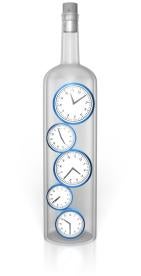Implementation of the National Labor Relations Board’s ambush election rule is in full swing, and, after seven weeks of experience under the new rule, NLRB case data reveal a dramatic reduction in the time between the filing of a certification petition and the NLRB’s conduct of an election.
Conclusions: Analysis of Representation Cases Shows 35% Reduction in Campaign Time.
An analysis of petition filings and other NLRB docket activity over 2014 and 2015, including in 222 representation cases filed at the NLRB during the period beginning April 14, 2015, the effective date of the new NLRB rules, and ending June 5, 2015, shows a dramatic impact on the time available to employees to become informed about how a union will affect their lives in the work place:
-
Comparing the period April 14 through June 5 (the “Relevant Period”) in 2014 with the same Relevant Period in 2015, the median number of days from petition to election at a polling place (excluding mail-ballot elections) declined by 35 percent. The median number of days between petition and election for petitions filed in the Relevant Period in 2014 was 38, and the median number of days for petitions filed in the Relevant Period in 2015 was 24. (Chart 1.)
-
Comparing the Relevant Period in 2014 with the Relevant Period in 2015, the average number of days from petition to either polling-place election or counting of mail-ballots declined by 35 percent. For petitions filed in the Relevant Period in 2014, the average number of days between petition and polling-place election or mail-ballot counting was 41.4, and for petitions filed in the Relevant Period in 2015 in which an election was scheduled as of June 5, 2015, the average number of days was 27.2. (Chart 2.)
-
The average number of days between petition and scheduled election in representation cases filed during the Relevant Period in 2015 in which an election at a polling place was scheduled as of June 5, 2015, was 24.8 days. (Chart 3.)
-
The average number of days between petition and scheduled counting of mail-ballots in representation cases filed during the Relevant Period in 2015 in which a mail-ballot election was scheduled as of June 5, 2015, was 37.7 days. (Chart 3.)
-
In representation cases filed during the Relevant Period in 2015 in which either a polling-place election or counting of ballots in a mail-ballot election was scheduled as of June 5, 2015, the average number of days between petition and scheduled election or ballot counting was 27 days. (Chart 3.)
-
During the Relevant Period in 2015, the rate at which unions won representation elections in 71 elections as reported as of June 5, 2015, was 62.0 percent, which is within the recent historical range of unions’ win rates. Based on NLRB historical data, in the NLRB’s fiscal years 2004 through 2013, unions’ average win rate in representation elections was 63.3 percent, with the highest percentage of 68.5 percent occurring in 2009 and the lowest percentage of 57.2 percent occurring in 2004.
Analysis: On Average, Workers’ Time for Learning About Unions Will Be Cut by Two Weeks.
The Board’s final rule does not mandate that an election occur within a certain period of time, but the new procedural requirements for the filing and processing of representation petitions has caused a dramatic reduction in the average and median times between the filing of a petition and the conduct of an NLRB secret-ballot election. In the years 2004 through 2013, the median time between petition and election was 37-39 days. From 2010 through 2013, the median time from petition to election was 38 days.
Under the new rules, for the Relevant Period, the median time between petition and a polling-place election was 24 days, and the average time between petition and either a polling-place election or mail-ballot election was 27.2 days. The reduction by 35 percent of the average and median times between petition and election is a dramatic change for workers and employers. On average, employers have 14 fewer days to communicate with their employees about how a union can and will affect the working lives of employees. In addition to having far less time during which to communicate with employees, employers have a dramatically increased administrative burden that they must carry at the same time that they are engaging with employees about the election issues. The new rules require, among other things, that the employer file a written position statement within seven days of the filing of the petition in order avoid waiving the employer’s legal arguments.
For their part, employees have an average of 14 fewer days to become informed about union rules, union dues, bargaining, how unions really operate, and other issues, before they make their decision. Employees are often unschooled in how unions and collective bargaining actually affect workers, and the reduction in time available for them to learn important details will prevent many from making a fully informed choice.
The effect of the new NLRB rule on union win rates also could be significant. In union organizing drives, organizers often conduct their activities underground and employers have no hint of organizing activity until the union files its petition at the NLRB. The NLRB’s election data show that, under the Board’s old rules, unions’ average win rate during the period 2004 through 2013 was 63.3 percent. By effectively shortening the time between petition and election, the NLRB rule is expected to increase organized labor’s win rate. Time and future election results will tell whether that expectation will be fulfilled.
The early election-results data are incomplete, but based on NLRB docket information, during the Relevant Period in 2014, the Board conducted 240 elections, and during the Relevant Period in 2015, as of June 5, 2015, the Board had conducted 71 elections and had an additional 151 elections scheduled. The results in the 151 remaining elections, as well as the results in other cases filed since the Relevant Period in 2015, will determine whether the new rule will produce a higher win rate for unions. So far, based on NLRB’s reported docket activity as of June 5, 2015, the unions’ win rate of 62 percent in the 71 elections completed as of June 5, 2015, is consistent with unions’ 10-year average win rate of 63.3 percent. With more cases over time and more complete docket information, the data will enable more confidence in analytical conclusions relating to election results, which will permit more focused employer strategies.
The NLRB rule, also known as the “quickie election” rule or the “ambush election” rule, eliminates pre-election evidentiary hearings and requests for review and defers decision on virtually all issues relating to appropriateness of units and voter eligibility now decided at the pre-election stage. The rule also expands the personal information relating to employees which employers are required to disclose to unions in voter eligibility lists known as “Excelsior lists.” Specifically, the Board will require that both telephone numbers, including mobile phone numbers, and email addresses, if available, be included along with employees’ names and addresses. In addition, the NLRB now requires that the employer disclose the employee’s work location, shift, and classification.
Methodology.
The results stated above are based on NLRB reports and docket activity as of June 5, 2015, in the cases identified in Table 1 and Table 2 at the end of this article. The NLRB reports and dockets are available at www.nlrb.gov. Dates of election and mail-ballot vote counting for cases filed during the period April 5, 2015, through June 5, 2015, were obtained primarily by examining Notices of Election and other docketed documents. Many of the cases filed during the Relevant Period in 2015 were still in progress as of June 5, 2015, the latest date on which documents in the cases were examined. Accordingly, while examination of the dockets for 222 cases filed during the Relevant Period in 2015 produced election or vote-counting dates, the dockets in other cases filed during the Relevant Period in 2015 and generally cases filed later in the period, did not have Notices of Election, Certifications of Representatives, Certifications of Results or other documents which would provide dates of election and vote-counting or election results.
Dates of election and mail-ballot counting for cases filed during the period April 5, 2014, through June 5, 2014, were obtained from reports entitled “NLRB Elections with 1 Labor Organization,” “NLRB Elections with 2 Labor Organizations,” and “NLRB Elections with 3 Labor Organizations” and documents available on the NLRB’s dockets.




 i
i


